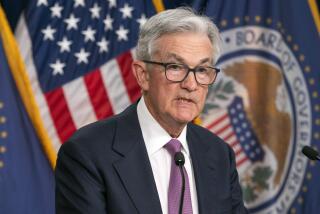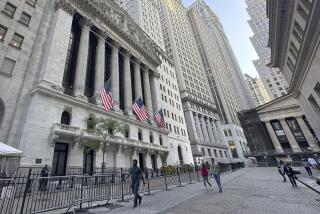Fed chief gives downbeat outlook on economy
WASHINGTON — Federal Reserve Chairman Ben S. Bernanke offered a bleak assessment of the economy, stirring more speculation that the central bank would spring into action to boost the flagging recovery.
But the Fed chief gave no hint that any move was imminent. And several analysts concluded after his testimony to lawmakers Tuesday that the Fed was now likely to sit tight this summer, waiting until at least its mid-September meeting before undertaking new efforts to spur growth.
“It seems like the bar to doing additional stimulus is higher than the market thinks,” said Chris Rupkey, chief financial economist at Bank of Tokyo-Mitsubishi in New York. “There is just no smoking gun here that suggests they’re getting ready to move at the next meeting” that starts July 31.
In presenting his semiannual report on monetary policy, Bernanke also addressed the recent scandal over the international benchmark interest rate known as the London Interbank Offered Rate, or LIBOR.
He defended the central bank’s response to allegations that Barclays and other large banks manipulated the market-based index, but said the method for setting the rate was “structurally flawed.”
The tone of his remarks on the economy was grimmer than some analysts were expecting, and stock markets initially fell before recovering to end the day moderately higher. Analysts said some investors may have reckoned that Bernanke was laying the groundwork for further stimulus.
Bernanke said the recovery had lost momentum in the second quarter, with key drivers of the economy — manufacturing, household spending and business investment — all having weakened. Only housing has shown some modest signs of life, he said.
The Fed’s latest projections call for the economy to grow 1.9% to 2.4% this year, but most analysts see the second-quarter growth rate falling to 1% to 1.5% after a lackluster expansion of 1.9% in the first quarter.
“Given that growth is projected to be not much above the rate needed to absorb new entrants to the labor force, the reduction in the unemployment rate seems likely to be frustratingly slow,” Bernanke said.
He told the Senate Banking Committee that the Fed stood ready to take further action.
“We are looking very carefully at the economy, trying to judge whether or not the loss of momentum we’ve seen recently is enduring,” he said, “and whether or not the economy is likely to continue to make progress toward lower unemployment and more satisfactory labor-market conditions.”
Democrats prodded Bernanke to do more — and fast. Sen. Charles E. Schumer (D-N.Y.) asked Bernanke whether there was a big risk of inflation in the next few years. Bernanke said he didn’t think so.
“And you certainly agree that unemployment has been too high and is sticky, and despite false — two false — starts that we’re having a much rougher time than we ever imagined getting unemployment down?” Schumer asked.
“Yes, that’s true,” Bernanke replied.
“So get to work, Mr. Chairman,” Schumer said. Bernanke smiled.
Republican Sen. Bob Corker of Tennessee, on the other hand, asked whether the best tonic for the economy wasn’t “real balanced fiscal reform?”
Bernanke said he welcomed action that would stabilize the nation’s debt, but cautioned against short-term cuts that could jeopardize the recovery.
A complication for Bernanke is that the Fed policy-setting committee appears divided; some members, worried about inflation, are not convinced further stimulus is needed.
Bernanke and his colleagues also are wrestling with exactly what to do.
Since late 2008, the Fed has kept its short-term interest rate near zero, and earlier this year policymakers said it’s likely to stay there until at least through 2014. The central bank could decide to extend the low-rate pledge.
Bernanke said Tuesday that the Fed also could lower the rate it pays banks for parking their reserves with the central bank, a move aimed at pushing banks to lend the money to businesses. But analysts see that as a risky move.
Most experts are looking for the Fed to launch another round of big purchases of bonds, most likely mortgage-backed securities, to boost the housing market and hold down long-term interest rates. Analysts and Fed officials are divided about its potential effectiveness.
“I think the Fed is leaning toward providing additional stimulus,” said Ryan Sweet, who watches the Fed for Moody’s Analytics. “It’s more a matter of when and what tool” they use.
In making his first public comments on the scandal over LIBOR, Bernanke said the allegations were “very troubling” and suggested that a better market-based index be used to set interest rates.
The rate, which is key to determining borrowing costs for businesses and consumers, is monitored in the U.S. by the Federal Reserve Bank of New York.
Bernanke said he could not say that the rate was reliable because the private group that oversees it has not acted on reform recommendations made in 2008 by the New York Fed.
In June, British investment bank Barclays agreed to pay $450 million to settle rate-manipulation charges filed by U.S. and British officials, whose investigation is continuing.
The House Financial Services Committee launched its own investigation Monday, and members are likely to question Bernanke about the issue during a hearing Wednesday.
More to Read
Inside the business of entertainment
The Wide Shot brings you news, analysis and insights on everything from streaming wars to production — and what it all means for the future.
You may occasionally receive promotional content from the Los Angeles Times.












